CRIM304: Fingerprint Identification vs. Bertillon Method in Forensics
VerifiedAdded on 2022/09/09
|13
|3023
|23
Essay
AI Summary
This essay delves into the realm of forensic science, focusing on the evolution of identification methods within the criminal justice system. It begins by highlighting the crucial role of forensic science, particularly fingerprinting, in identifying criminals and securing convictions. The paper then contrasts the fingerprint method with the Bertillon system, an early anthropometric approach to identification, and examines the pivotal William West and Will West case, which exposed the limitations of the Bertillon method and paved the way for the widespread adoption of fingerprinting. The discussion covers key historical developments, including the contributions of Dr. Henry Faulds, Alphonse Bertillon, Juan Vucetich, and Francis Galton. Furthermore, it explores the impact of fingerprinting on legal proceedings, such as the Deptford Murder Trial, and details the introduction of fingerprinting to the United States. The essay concludes by emphasizing the superiority of fingerprinting over anthropometry and its enduring significance as a reliable means of personal identification in modern forensic science.
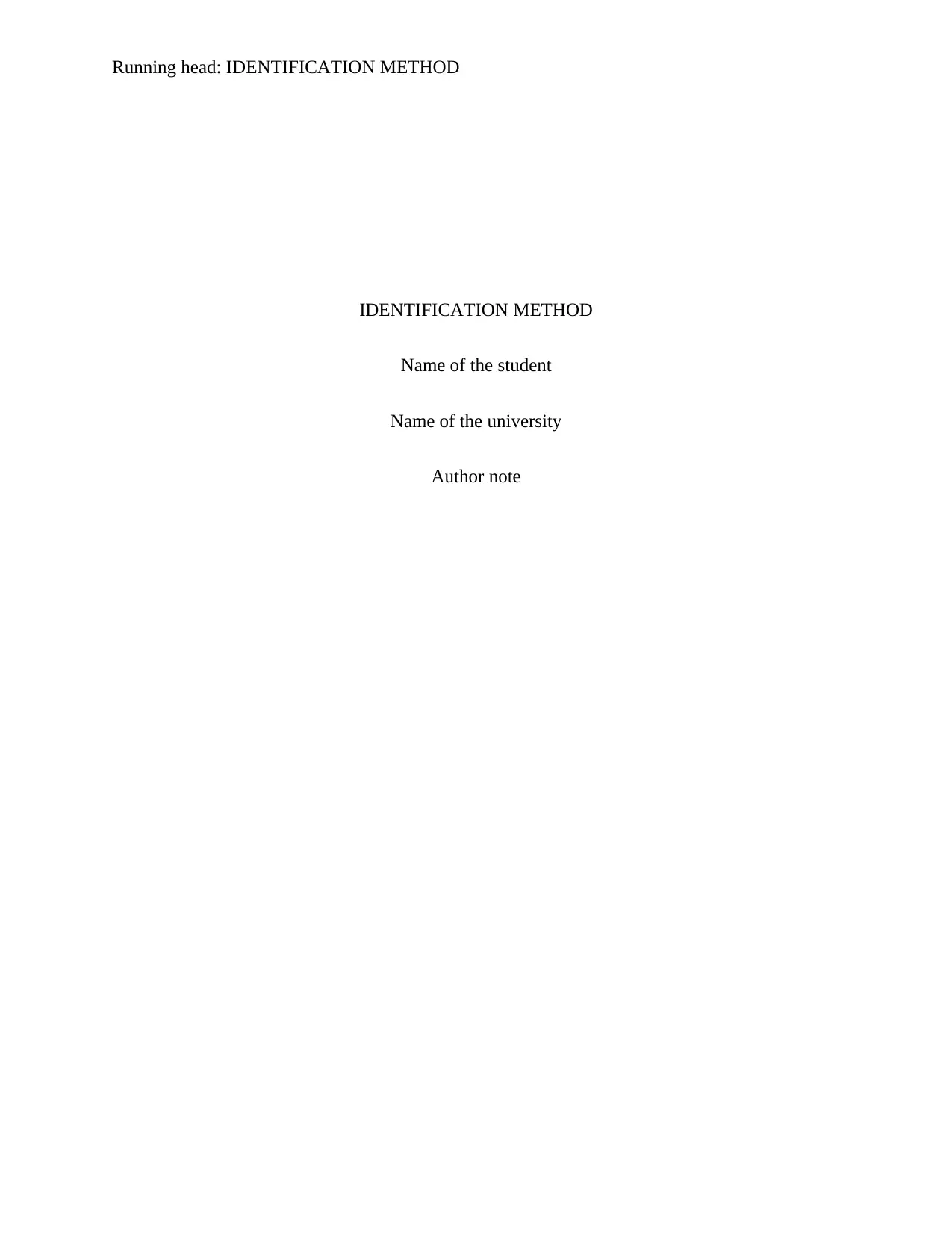
Running head: IDENTIFICATION METHOD
IDENTIFICATION METHOD
Name of the student
Name of the university
Author note
IDENTIFICATION METHOD
Name of the student
Name of the university
Author note
Paraphrase This Document
Need a fresh take? Get an instant paraphrase of this document with our AI Paraphraser
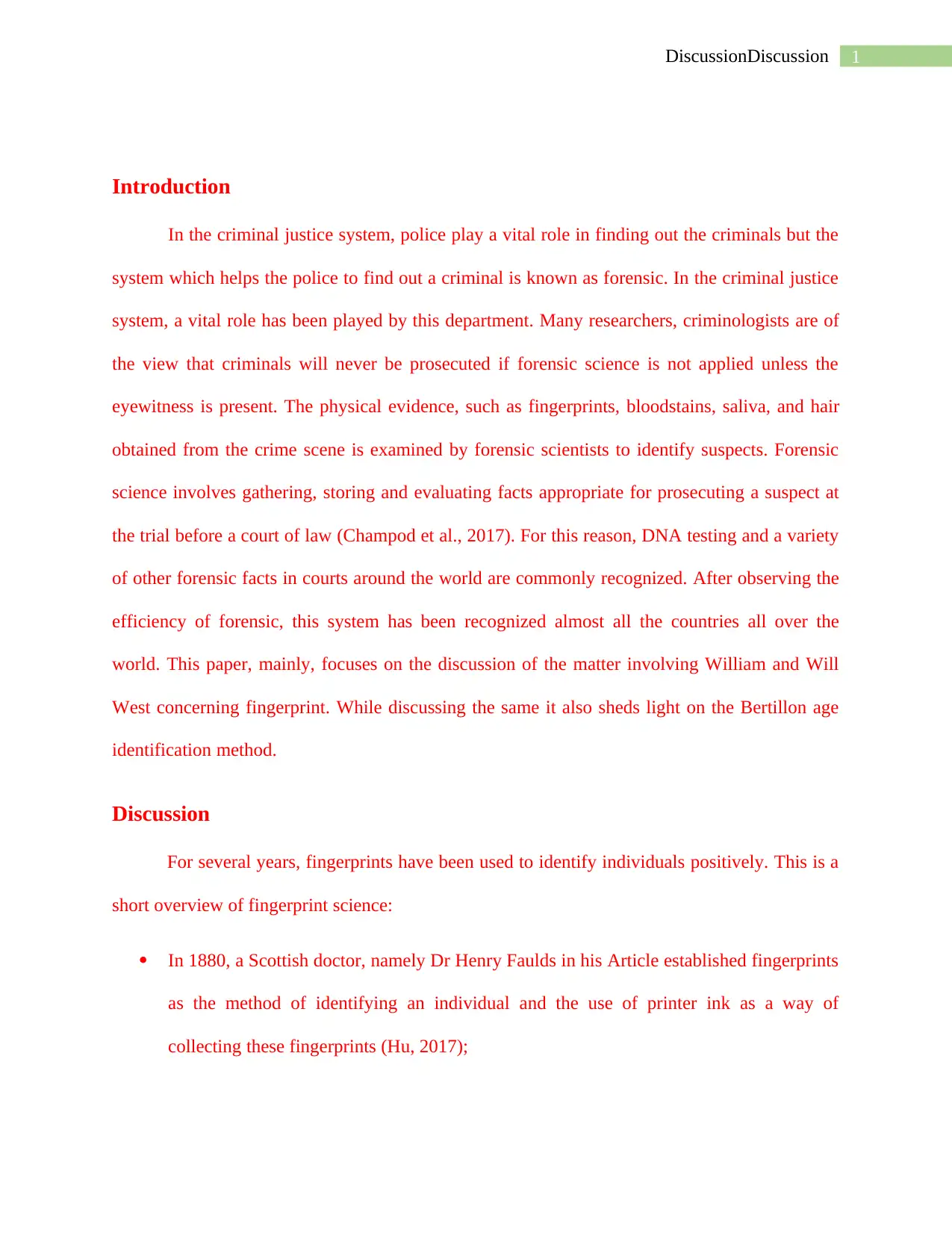
1DiscussionDiscussion
Introduction
In the criminal justice system, police play a vital role in finding out the criminals but the
system which helps the police to find out a criminal is known as forensic. In the criminal justice
system, a vital role has been played by this department. Many researchers, criminologists are of
the view that criminals will never be prosecuted if forensic science is not applied unless the
eyewitness is present. The physical evidence, such as fingerprints, bloodstains, saliva, and hair
obtained from the crime scene is examined by forensic scientists to identify suspects. Forensic
science involves gathering, storing and evaluating facts appropriate for prosecuting a suspect at
the trial before a court of law (Champod et al., 2017). For this reason, DNA testing and a variety
of other forensic facts in courts around the world are commonly recognized. After observing the
efficiency of forensic, this system has been recognized almost all the countries all over the
world. This paper, mainly, focuses on the discussion of the matter involving William and Will
West concerning fingerprint. While discussing the same it also sheds light on the Bertillon age
identification method.
Discussion
For several years, fingerprints have been used to identify individuals positively. This is a
short overview of fingerprint science:
In 1880, a Scottish doctor, namely Dr Henry Faulds in his Article established fingerprints
as the method of identifying an individual and the use of printer ink as a way of
collecting these fingerprints (Hu, 2017);
Introduction
In the criminal justice system, police play a vital role in finding out the criminals but the
system which helps the police to find out a criminal is known as forensic. In the criminal justice
system, a vital role has been played by this department. Many researchers, criminologists are of
the view that criminals will never be prosecuted if forensic science is not applied unless the
eyewitness is present. The physical evidence, such as fingerprints, bloodstains, saliva, and hair
obtained from the crime scene is examined by forensic scientists to identify suspects. Forensic
science involves gathering, storing and evaluating facts appropriate for prosecuting a suspect at
the trial before a court of law (Champod et al., 2017). For this reason, DNA testing and a variety
of other forensic facts in courts around the world are commonly recognized. After observing the
efficiency of forensic, this system has been recognized almost all the countries all over the
world. This paper, mainly, focuses on the discussion of the matter involving William and Will
West concerning fingerprint. While discussing the same it also sheds light on the Bertillon age
identification method.
Discussion
For several years, fingerprints have been used to identify individuals positively. This is a
short overview of fingerprint science:
In 1880, a Scottish doctor, namely Dr Henry Faulds in his Article established fingerprints
as the method of identifying an individual and the use of printer ink as a way of
collecting these fingerprints (Hu, 2017);
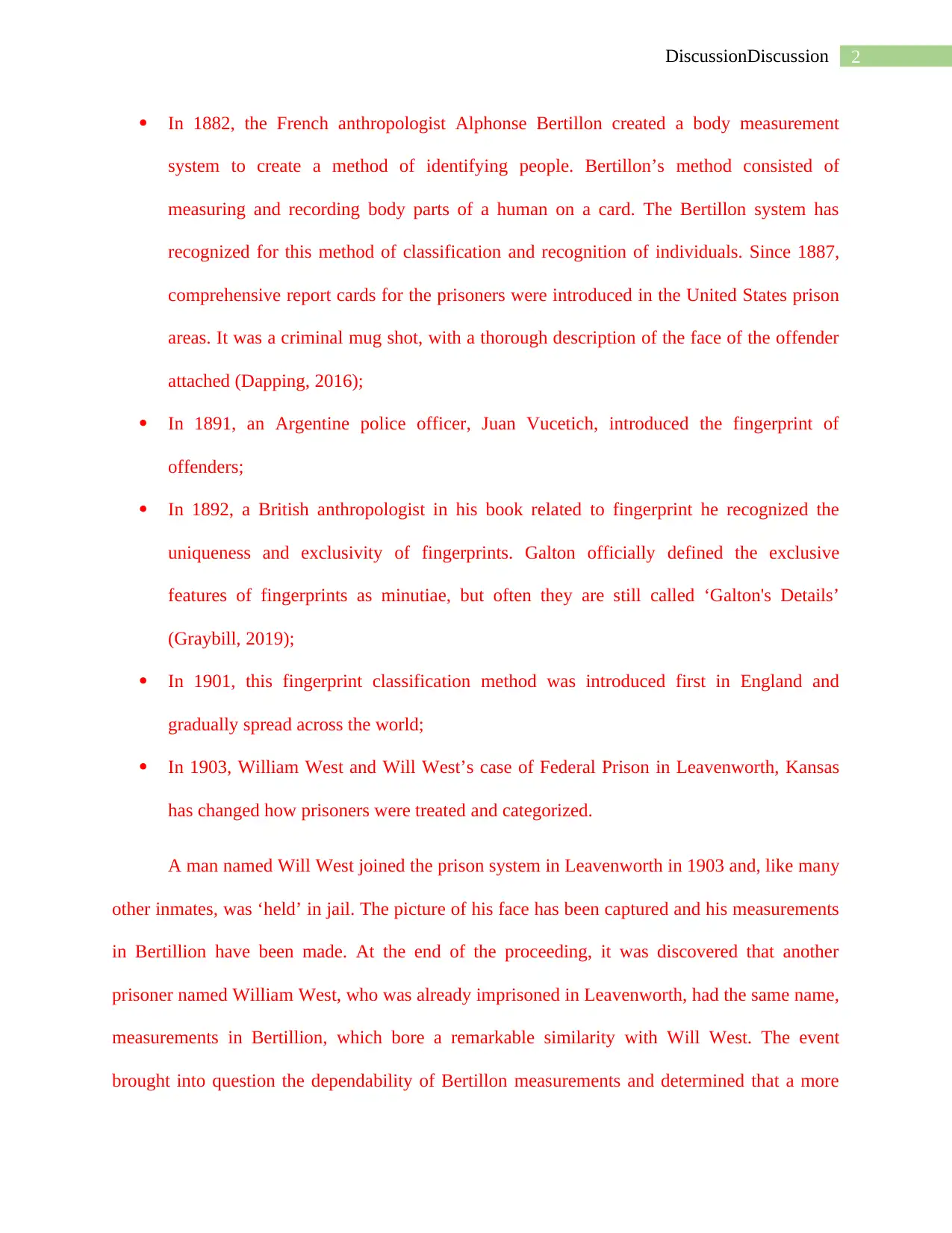
2DiscussionDiscussion
In 1882, the French anthropologist Alphonse Bertillon created a body measurement
system to create a method of identifying people. Bertillon’s method consisted of
measuring and recording body parts of a human on a card. The Bertillon system has
recognized for this method of classification and recognition of individuals. Since 1887,
comprehensive report cards for the prisoners were introduced in the United States prison
areas. It was a criminal mug shot, with a thorough description of the face of the offender
attached (Dapping, 2016);
In 1891, an Argentine police officer, Juan Vucetich, introduced the fingerprint of
offenders;
In 1892, a British anthropologist in his book related to fingerprint he recognized the
uniqueness and exclusivity of fingerprints. Galton officially defined the exclusive
features of fingerprints as minutiae, but often they are still called ‘Galton's Details’
(Graybill, 2019);
In 1901, this fingerprint classification method was introduced first in England and
gradually spread across the world;
In 1903, William West and Will West’s case of Federal Prison in Leavenworth, Kansas
has changed how prisoners were treated and categorized.
A man named Will West joined the prison system in Leavenworth in 1903 and, like many
other inmates, was ‘held’ in jail. The picture of his face has been captured and his measurements
in Bertillion have been made. At the end of the proceeding, it was discovered that another
prisoner named William West, who was already imprisoned in Leavenworth, had the same name,
measurements in Bertillion, which bore a remarkable similarity with Will West. The event
brought into question the dependability of Bertillon measurements and determined that a more
In 1882, the French anthropologist Alphonse Bertillon created a body measurement
system to create a method of identifying people. Bertillon’s method consisted of
measuring and recording body parts of a human on a card. The Bertillon system has
recognized for this method of classification and recognition of individuals. Since 1887,
comprehensive report cards for the prisoners were introduced in the United States prison
areas. It was a criminal mug shot, with a thorough description of the face of the offender
attached (Dapping, 2016);
In 1891, an Argentine police officer, Juan Vucetich, introduced the fingerprint of
offenders;
In 1892, a British anthropologist in his book related to fingerprint he recognized the
uniqueness and exclusivity of fingerprints. Galton officially defined the exclusive
features of fingerprints as minutiae, but often they are still called ‘Galton's Details’
(Graybill, 2019);
In 1901, this fingerprint classification method was introduced first in England and
gradually spread across the world;
In 1903, William West and Will West’s case of Federal Prison in Leavenworth, Kansas
has changed how prisoners were treated and categorized.
A man named Will West joined the prison system in Leavenworth in 1903 and, like many
other inmates, was ‘held’ in jail. The picture of his face has been captured and his measurements
in Bertillion have been made. At the end of the proceeding, it was discovered that another
prisoner named William West, who was already imprisoned in Leavenworth, had the same name,
measurements in Bertillion, which bore a remarkable similarity with Will West. The event
brought into question the dependability of Bertillon measurements and determined that a more
⊘ This is a preview!⊘
Do you want full access?
Subscribe today to unlock all pages.

Trusted by 1+ million students worldwide
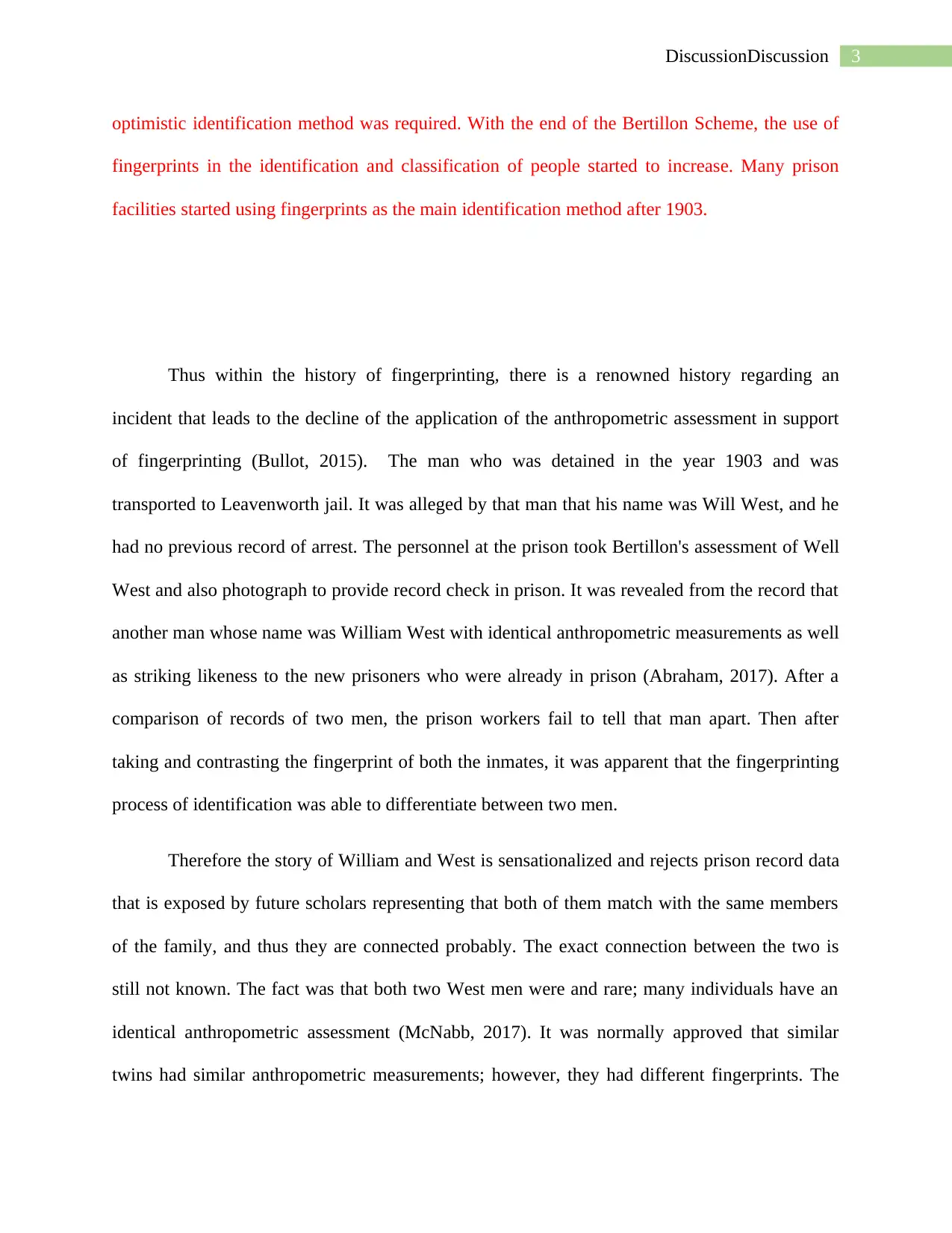
3DiscussionDiscussion
optimistic identification method was required. With the end of the Bertillon Scheme, the use of
fingerprints in the identification and classification of people started to increase. Many prison
facilities started using fingerprints as the main identification method after 1903.
Thus within the history of fingerprinting, there is a renowned history regarding an
incident that leads to the decline of the application of the anthropometric assessment in support
of fingerprinting (Bullot, 2015). The man who was detained in the year 1903 and was
transported to Leavenworth jail. It was alleged by that man that his name was Will West, and he
had no previous record of arrest. The personnel at the prison took Bertillon's assessment of Well
West and also photograph to provide record check in prison. It was revealed from the record that
another man whose name was William West with identical anthropometric measurements as well
as striking likeness to the new prisoners who were already in prison (Abraham, 2017). After a
comparison of records of two men, the prison workers fail to tell that man apart. Then after
taking and contrasting the fingerprint of both the inmates, it was apparent that the fingerprinting
process of identification was able to differentiate between two men.
Therefore the story of William and West is sensationalized and rejects prison record data
that is exposed by future scholars representing that both of them match with the same members
of the family, and thus they are connected probably. The exact connection between the two is
still not known. The fact was that both two West men were and rare; many individuals have an
identical anthropometric assessment (McNabb, 2017). It was normally approved that similar
twins had similar anthropometric measurements; however, they had different fingerprints. The
optimistic identification method was required. With the end of the Bertillon Scheme, the use of
fingerprints in the identification and classification of people started to increase. Many prison
facilities started using fingerprints as the main identification method after 1903.
Thus within the history of fingerprinting, there is a renowned history regarding an
incident that leads to the decline of the application of the anthropometric assessment in support
of fingerprinting (Bullot, 2015). The man who was detained in the year 1903 and was
transported to Leavenworth jail. It was alleged by that man that his name was Will West, and he
had no previous record of arrest. The personnel at the prison took Bertillon's assessment of Well
West and also photograph to provide record check in prison. It was revealed from the record that
another man whose name was William West with identical anthropometric measurements as well
as striking likeness to the new prisoners who were already in prison (Abraham, 2017). After a
comparison of records of two men, the prison workers fail to tell that man apart. Then after
taking and contrasting the fingerprint of both the inmates, it was apparent that the fingerprinting
process of identification was able to differentiate between two men.
Therefore the story of William and West is sensationalized and rejects prison record data
that is exposed by future scholars representing that both of them match with the same members
of the family, and thus they are connected probably. The exact connection between the two is
still not known. The fact was that both two West men were and rare; many individuals have an
identical anthropometric assessment (McNabb, 2017). It was normally approved that similar
twins had similar anthropometric measurements; however, they had different fingerprints. The
Paraphrase This Document
Need a fresh take? Get an instant paraphrase of this document with our AI Paraphraser
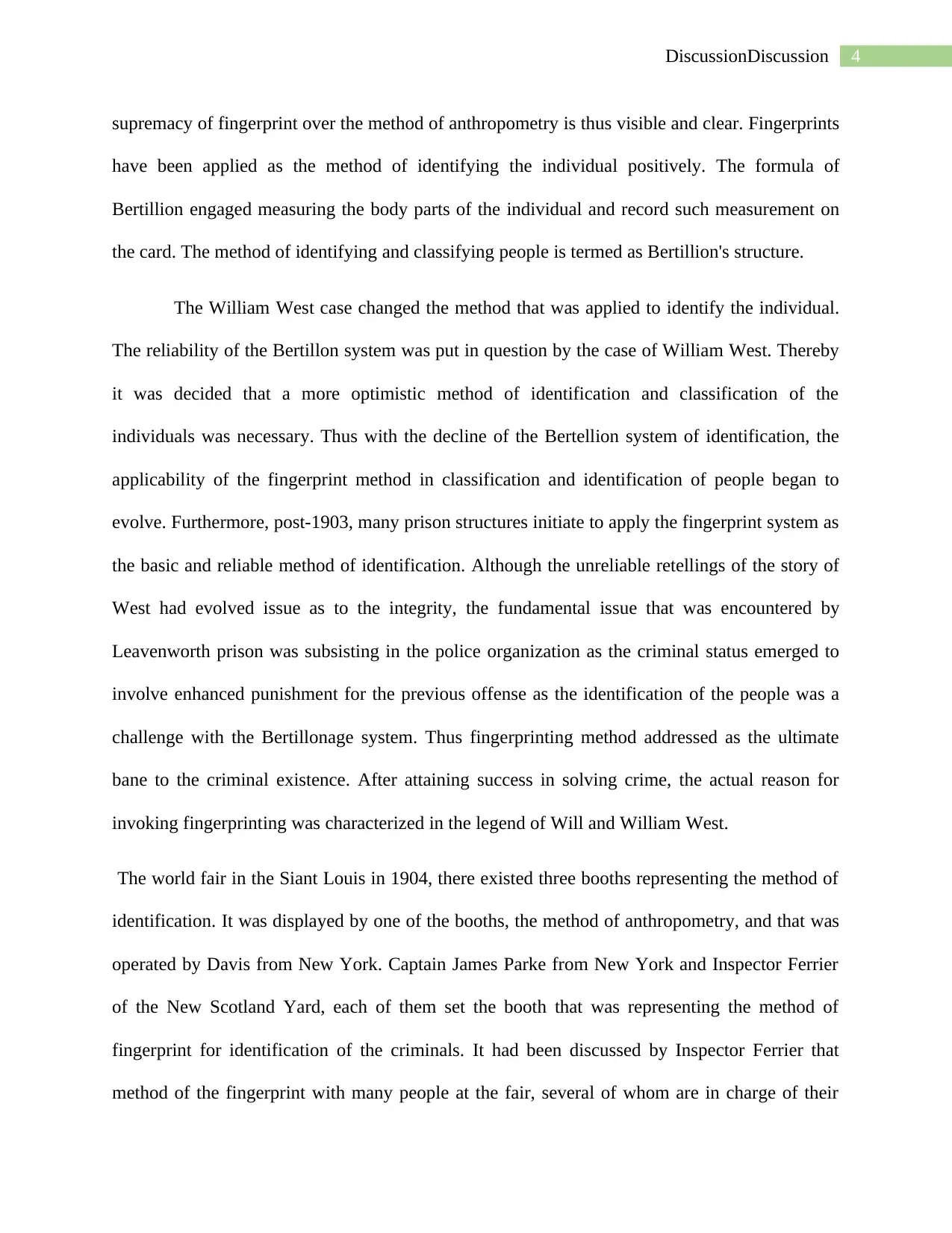
4DiscussionDiscussion
supremacy of fingerprint over the method of anthropometry is thus visible and clear. Fingerprints
have been applied as the method of identifying the individual positively. The formula of
Bertillion engaged measuring the body parts of the individual and record such measurement on
the card. The method of identifying and classifying people is termed as Bertillion's structure.
The William West case changed the method that was applied to identify the individual.
The reliability of the Bertillon system was put in question by the case of William West. Thereby
it was decided that a more optimistic method of identification and classification of the
individuals was necessary. Thus with the decline of the Bertellion system of identification, the
applicability of the fingerprint method in classification and identification of people began to
evolve. Furthermore, post-1903, many prison structures initiate to apply the fingerprint system as
the basic and reliable method of identification. Although the unreliable retellings of the story of
West had evolved issue as to the integrity, the fundamental issue that was encountered by
Leavenworth prison was subsisting in the police organization as the criminal status emerged to
involve enhanced punishment for the previous offense as the identification of the people was a
challenge with the Bertillonage system. Thus fingerprinting method addressed as the ultimate
bane to the criminal existence. After attaining success in solving crime, the actual reason for
invoking fingerprinting was characterized in the legend of Will and William West.
The world fair in the Siant Louis in 1904, there existed three booths representing the method of
identification. It was displayed by one of the booths, the method of anthropometry, and that was
operated by Davis from New York. Captain James Parke from New York and Inspector Ferrier
of the New Scotland Yard, each of them set the booth that was representing the method of
fingerprint for identification of the criminals. It had been discussed by Inspector Ferrier that
method of the fingerprint with many people at the fair, several of whom are in charge of their
supremacy of fingerprint over the method of anthropometry is thus visible and clear. Fingerprints
have been applied as the method of identifying the individual positively. The formula of
Bertillion engaged measuring the body parts of the individual and record such measurement on
the card. The method of identifying and classifying people is termed as Bertillion's structure.
The William West case changed the method that was applied to identify the individual.
The reliability of the Bertillon system was put in question by the case of William West. Thereby
it was decided that a more optimistic method of identification and classification of the
individuals was necessary. Thus with the decline of the Bertellion system of identification, the
applicability of the fingerprint method in classification and identification of people began to
evolve. Furthermore, post-1903, many prison structures initiate to apply the fingerprint system as
the basic and reliable method of identification. Although the unreliable retellings of the story of
West had evolved issue as to the integrity, the fundamental issue that was encountered by
Leavenworth prison was subsisting in the police organization as the criminal status emerged to
involve enhanced punishment for the previous offense as the identification of the people was a
challenge with the Bertillonage system. Thus fingerprinting method addressed as the ultimate
bane to the criminal existence. After attaining success in solving crime, the actual reason for
invoking fingerprinting was characterized in the legend of Will and William West.
The world fair in the Siant Louis in 1904, there existed three booths representing the method of
identification. It was displayed by one of the booths, the method of anthropometry, and that was
operated by Davis from New York. Captain James Parke from New York and Inspector Ferrier
of the New Scotland Yard, each of them set the booth that was representing the method of
fingerprint for identification of the criminals. It had been discussed by Inspector Ferrier that
method of the fingerprint with many people at the fair, several of whom are in charge of their

5DiscussionDiscussion
police institution throughout the United States (Levin, 2015). He also exhibited the invitees' an
example where the measurement of anthropometric on two individuals varies by millimeter in
addition to that how the fingerprint was diverse.
Furthermore, after fair, Ferrier stayed in the United States to learn to fingerprint
involving the method to apply powder to grow latent prints. The student of Ferrier went on to
learn to fingerprint to law enforcement as well as military communities all over America.
Inspector Ferrier and Major Mc. Claughry initiated fingerprinting the prisoners at Leavenworth,
federal prison. The record of fingerprint become the initiation of the United States government
collection of the fingerprint. In the year 1905, Inspector Charles gave evidence to the
individualization of the fingerprint of the suspected individual on the cash box. The case engages
the homicide of the individual, along with his wife.
Two brothers, namely Alfred and Stratton, were defendants. It had been explained by
Collins to the judge that the categorization of fingerprint and the method to impact on the
individualization. Then he showed the features that he had identified on the chart as matching the
right thumb of Stratton. It had been claimed by Collins throughout his period of experience he
had never observed two prints of having more than that of three features in common. In the case,
there were about 11 features in common (Becker & Dutelle, 2018). According to the statement
given by the supplementary eyewitnesses, the individualization of the right thumb impression of
Stratton was the robust portion of proof in the case. Both the brothers were held to be guilty of
the offense of murder in addition to that were condemned to death. The case was then mentioned
as the Deptford Murder Trial about the discourse of the offense. Furthermore, it was a leading
murder trial in England, where the fingerprint was implemented as proof (Bucholtz & Davis,
2015).
police institution throughout the United States (Levin, 2015). He also exhibited the invitees' an
example where the measurement of anthropometric on two individuals varies by millimeter in
addition to that how the fingerprint was diverse.
Furthermore, after fair, Ferrier stayed in the United States to learn to fingerprint
involving the method to apply powder to grow latent prints. The student of Ferrier went on to
learn to fingerprint to law enforcement as well as military communities all over America.
Inspector Ferrier and Major Mc. Claughry initiated fingerprinting the prisoners at Leavenworth,
federal prison. The record of fingerprint become the initiation of the United States government
collection of the fingerprint. In the year 1905, Inspector Charles gave evidence to the
individualization of the fingerprint of the suspected individual on the cash box. The case engages
the homicide of the individual, along with his wife.
Two brothers, namely Alfred and Stratton, were defendants. It had been explained by
Collins to the judge that the categorization of fingerprint and the method to impact on the
individualization. Then he showed the features that he had identified on the chart as matching the
right thumb of Stratton. It had been claimed by Collins throughout his period of experience he
had never observed two prints of having more than that of three features in common. In the case,
there were about 11 features in common (Becker & Dutelle, 2018). According to the statement
given by the supplementary eyewitnesses, the individualization of the right thumb impression of
Stratton was the robust portion of proof in the case. Both the brothers were held to be guilty of
the offense of murder in addition to that were condemned to death. The case was then mentioned
as the Deptford Murder Trial about the discourse of the offense. Furthermore, it was a leading
murder trial in England, where the fingerprint was implemented as proof (Bucholtz & Davis,
2015).
⊘ This is a preview!⊘
Do you want full access?
Subscribe today to unlock all pages.

Trusted by 1+ million students worldwide
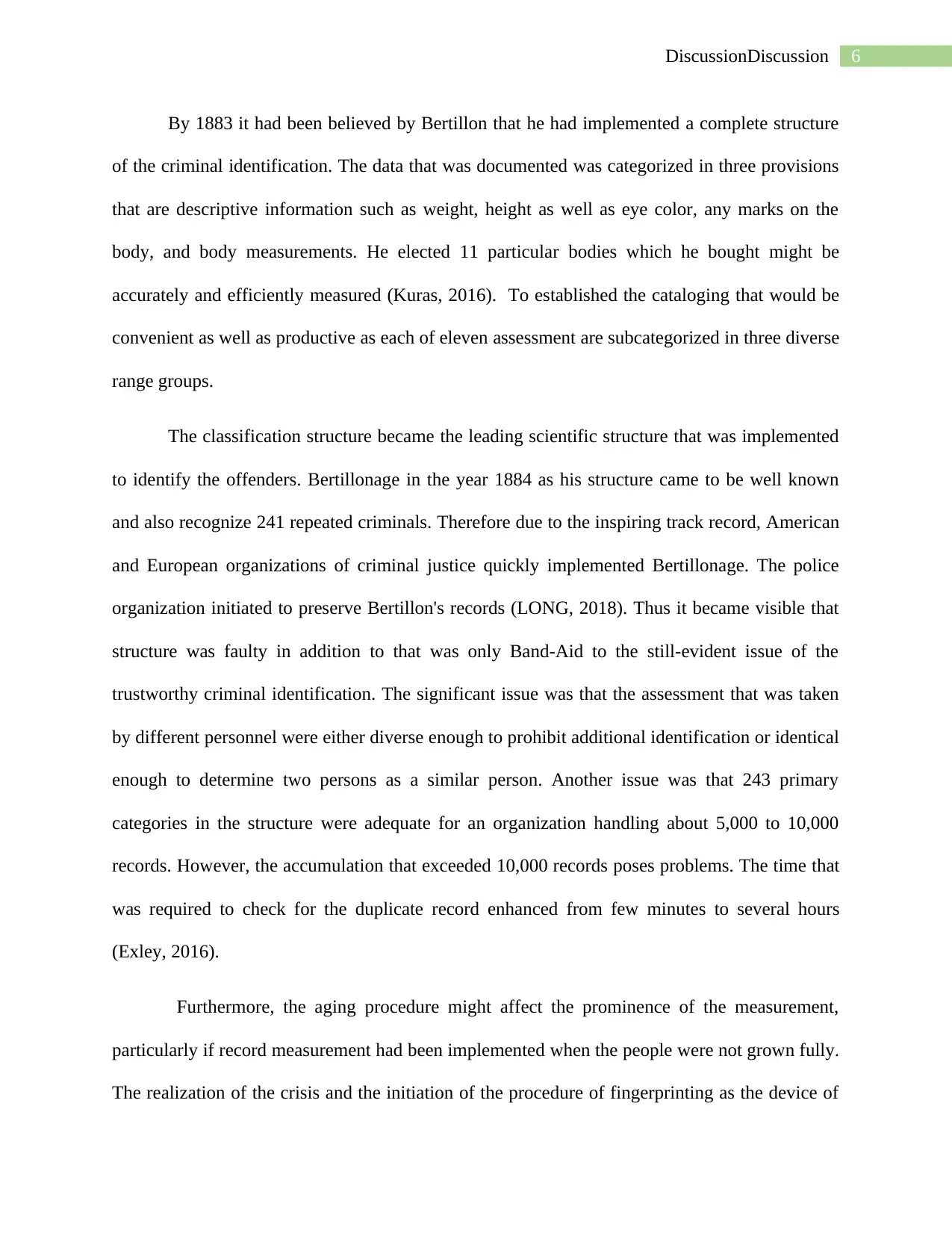
6DiscussionDiscussion
By 1883 it had been believed by Bertillon that he had implemented a complete structure
of the criminal identification. The data that was documented was categorized in three provisions
that are descriptive information such as weight, height as well as eye color, any marks on the
body, and body measurements. He elected 11 particular bodies which he bought might be
accurately and efficiently measured (Kuras, 2016). To established the cataloging that would be
convenient as well as productive as each of eleven assessment are subcategorized in three diverse
range groups.
The classification structure became the leading scientific structure that was implemented
to identify the offenders. Bertillonage in the year 1884 as his structure came to be well known
and also recognize 241 repeated criminals. Therefore due to the inspiring track record, American
and European organizations of criminal justice quickly implemented Bertillonage. The police
organization initiated to preserve Bertillon's records (LONG, 2018). Thus it became visible that
structure was faulty in addition to that was only Band-Aid to the still-evident issue of the
trustworthy criminal identification. The significant issue was that the assessment that was taken
by different personnel were either diverse enough to prohibit additional identification or identical
enough to determine two persons as a similar person. Another issue was that 243 primary
categories in the structure were adequate for an organization handling about 5,000 to 10,000
records. However, the accumulation that exceeded 10,000 records poses problems. The time that
was required to check for the duplicate record enhanced from few minutes to several hours
(Exley, 2016).
Furthermore, the aging procedure might affect the prominence of the measurement,
particularly if record measurement had been implemented when the people were not grown fully.
The realization of the crisis and the initiation of the procedure of fingerprinting as the device of
By 1883 it had been believed by Bertillon that he had implemented a complete structure
of the criminal identification. The data that was documented was categorized in three provisions
that are descriptive information such as weight, height as well as eye color, any marks on the
body, and body measurements. He elected 11 particular bodies which he bought might be
accurately and efficiently measured (Kuras, 2016). To established the cataloging that would be
convenient as well as productive as each of eleven assessment are subcategorized in three diverse
range groups.
The classification structure became the leading scientific structure that was implemented
to identify the offenders. Bertillonage in the year 1884 as his structure came to be well known
and also recognize 241 repeated criminals. Therefore due to the inspiring track record, American
and European organizations of criminal justice quickly implemented Bertillonage. The police
organization initiated to preserve Bertillon's records (LONG, 2018). Thus it became visible that
structure was faulty in addition to that was only Band-Aid to the still-evident issue of the
trustworthy criminal identification. The significant issue was that the assessment that was taken
by different personnel were either diverse enough to prohibit additional identification or identical
enough to determine two persons as a similar person. Another issue was that 243 primary
categories in the structure were adequate for an organization handling about 5,000 to 10,000
records. However, the accumulation that exceeded 10,000 records poses problems. The time that
was required to check for the duplicate record enhanced from few minutes to several hours
(Exley, 2016).
Furthermore, the aging procedure might affect the prominence of the measurement,
particularly if record measurement had been implemented when the people were not grown fully.
The realization of the crisis and the initiation of the procedure of fingerprinting as the device of
Paraphrase This Document
Need a fresh take? Get an instant paraphrase of this document with our AI Paraphraser
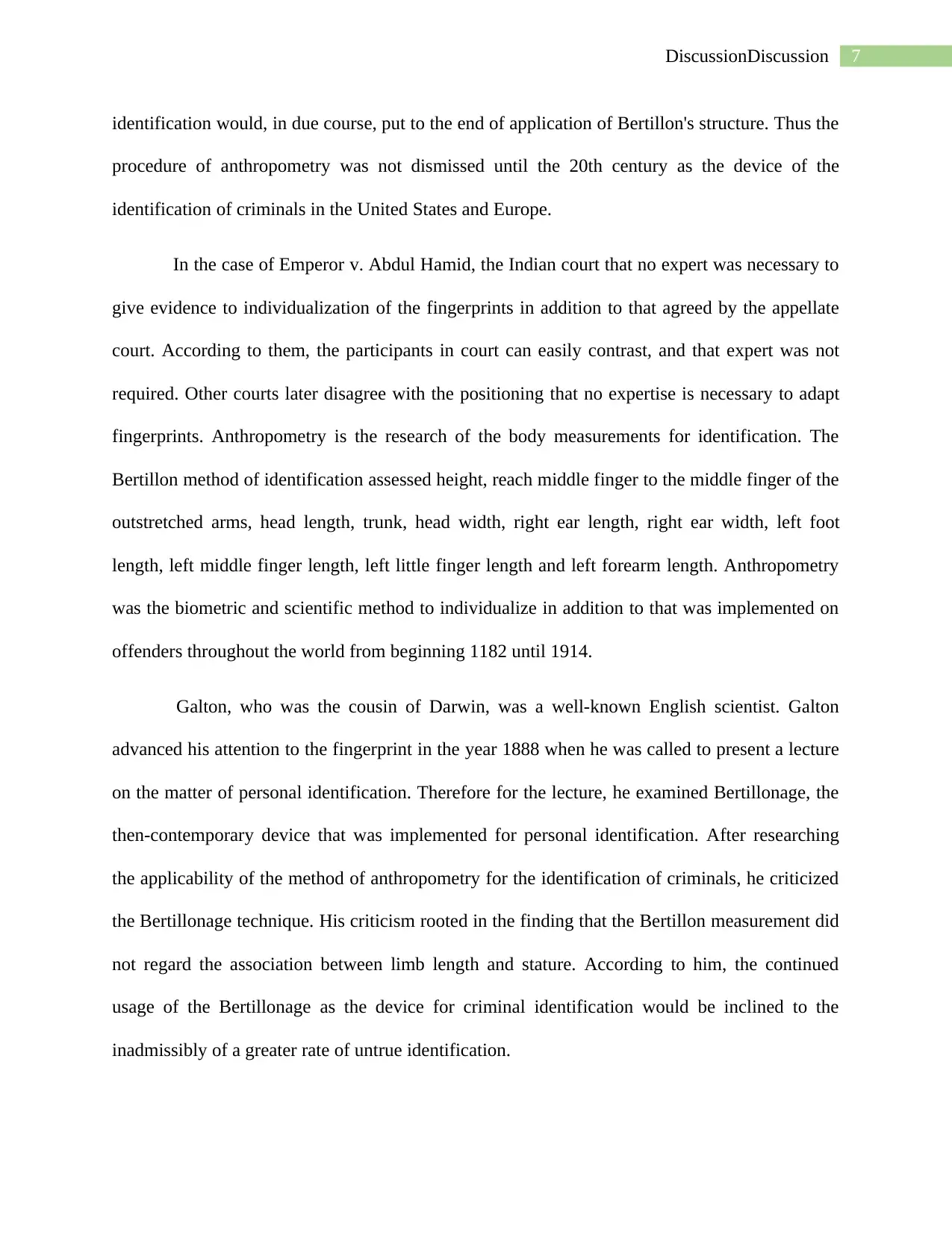
7DiscussionDiscussion
identification would, in due course, put to the end of application of Bertillon's structure. Thus the
procedure of anthropometry was not dismissed until the 20th century as the device of the
identification of criminals in the United States and Europe.
In the case of Emperor v. Abdul Hamid, the Indian court that no expert was necessary to
give evidence to individualization of the fingerprints in addition to that agreed by the appellate
court. According to them, the participants in court can easily contrast, and that expert was not
required. Other courts later disagree with the positioning that no expertise is necessary to adapt
fingerprints. Anthropometry is the research of the body measurements for identification. The
Bertillon method of identification assessed height, reach middle finger to the middle finger of the
outstretched arms, head length, trunk, head width, right ear length, right ear width, left foot
length, left middle finger length, left little finger length and left forearm length. Anthropometry
was the biometric and scientific method to individualize in addition to that was implemented on
offenders throughout the world from beginning 1182 until 1914.
Galton, who was the cousin of Darwin, was a well-known English scientist. Galton
advanced his attention to the fingerprint in the year 1888 when he was called to present a lecture
on the matter of personal identification. Therefore for the lecture, he examined Bertillonage, the
then-contemporary device that was implemented for personal identification. After researching
the applicability of the method of anthropometry for the identification of criminals, he criticized
the Bertillonage technique. His criticism rooted in the finding that the Bertillon measurement did
not regard the association between limb length and stature. According to him, the continued
usage of the Bertillonage as the device for criminal identification would be inclined to the
inadmissibly of a greater rate of untrue identification.
identification would, in due course, put to the end of application of Bertillon's structure. Thus the
procedure of anthropometry was not dismissed until the 20th century as the device of the
identification of criminals in the United States and Europe.
In the case of Emperor v. Abdul Hamid, the Indian court that no expert was necessary to
give evidence to individualization of the fingerprints in addition to that agreed by the appellate
court. According to them, the participants in court can easily contrast, and that expert was not
required. Other courts later disagree with the positioning that no expertise is necessary to adapt
fingerprints. Anthropometry is the research of the body measurements for identification. The
Bertillon method of identification assessed height, reach middle finger to the middle finger of the
outstretched arms, head length, trunk, head width, right ear length, right ear width, left foot
length, left middle finger length, left little finger length and left forearm length. Anthropometry
was the biometric and scientific method to individualize in addition to that was implemented on
offenders throughout the world from beginning 1182 until 1914.
Galton, who was the cousin of Darwin, was a well-known English scientist. Galton
advanced his attention to the fingerprint in the year 1888 when he was called to present a lecture
on the matter of personal identification. Therefore for the lecture, he examined Bertillonage, the
then-contemporary device that was implemented for personal identification. After researching
the applicability of the method of anthropometry for the identification of criminals, he criticized
the Bertillonage technique. His criticism rooted in the finding that the Bertillon measurement did
not regard the association between limb length and stature. According to him, the continued
usage of the Bertillonage as the device for criminal identification would be inclined to the
inadmissibly of a greater rate of untrue identification.

8DiscussionDiscussion
In addition to that, implementation of the Bertillon method was regarded as time-
consuming as well as the measurement may vary that grounded on who was taking the same as
the consequence of his aversion for the method of anthropometry Galton investigated the
applicability of fingerprint for the reason of personal individualization. His investigation inclined
him to "Faults' Article in Nature, as well as rebuttal letter that similar year by Sir William
Herschel stated that he first revealed print individualization and that was used in India since
1860.
After four years of concentrated research and study, he published the book named
"Finger Prints wherein he created that fingerprint is unique and permanent. Furthermore, he
appreciated that fingerprint to become the sustainable technique of the personal
individualization, understandable, systematic as well as the applicable structure of the
classification of a fingerprint had to be formulated. Therefore two years after book publication,
Galton's basic fingerprint classification structure was implemented in the Bertillonage records at
Scotland Yard (Dutelle & Becker, 2018). The classification structure established to be
rudimentary in respect of large sections of records in addition to that would nor create the
method of classifying and cataloging criminals.
Conclusion
Thus it can be concluded from the discussion mentioned above that the active and
dynamic nature of the processing of human identification enabling to become experts; however
also causes distorting the oncoming information in addition to that make incorrect decisions. The
vulnerabilities were not restricted to fingerprint professionals and also applicable equivalently to
other areas. Nevertheless, the significance of evidence of fingerprint being unbiasedly and
reliable needs that theses prospective drawbacks to having discoursed. A systematic investigation
In addition to that, implementation of the Bertillon method was regarded as time-
consuming as well as the measurement may vary that grounded on who was taking the same as
the consequence of his aversion for the method of anthropometry Galton investigated the
applicability of fingerprint for the reason of personal individualization. His investigation inclined
him to "Faults' Article in Nature, as well as rebuttal letter that similar year by Sir William
Herschel stated that he first revealed print individualization and that was used in India since
1860.
After four years of concentrated research and study, he published the book named
"Finger Prints wherein he created that fingerprint is unique and permanent. Furthermore, he
appreciated that fingerprint to become the sustainable technique of the personal
individualization, understandable, systematic as well as the applicable structure of the
classification of a fingerprint had to be formulated. Therefore two years after book publication,
Galton's basic fingerprint classification structure was implemented in the Bertillonage records at
Scotland Yard (Dutelle & Becker, 2018). The classification structure established to be
rudimentary in respect of large sections of records in addition to that would nor create the
method of classifying and cataloging criminals.
Conclusion
Thus it can be concluded from the discussion mentioned above that the active and
dynamic nature of the processing of human identification enabling to become experts; however
also causes distorting the oncoming information in addition to that make incorrect decisions. The
vulnerabilities were not restricted to fingerprint professionals and also applicable equivalently to
other areas. Nevertheless, the significance of evidence of fingerprint being unbiasedly and
reliable needs that theses prospective drawbacks to having discoursed. A systematic investigation
⊘ This is a preview!⊘
Do you want full access?
Subscribe today to unlock all pages.

Trusted by 1+ million students worldwide

9DiscussionDiscussion
should be conducted to analyzed psychological and cognitive factors engaged in the
identification of fingerprint.
should be conducted to analyzed psychological and cognitive factors engaged in the
identification of fingerprint.
Paraphrase This Document
Need a fresh take? Get an instant paraphrase of this document with our AI Paraphraser
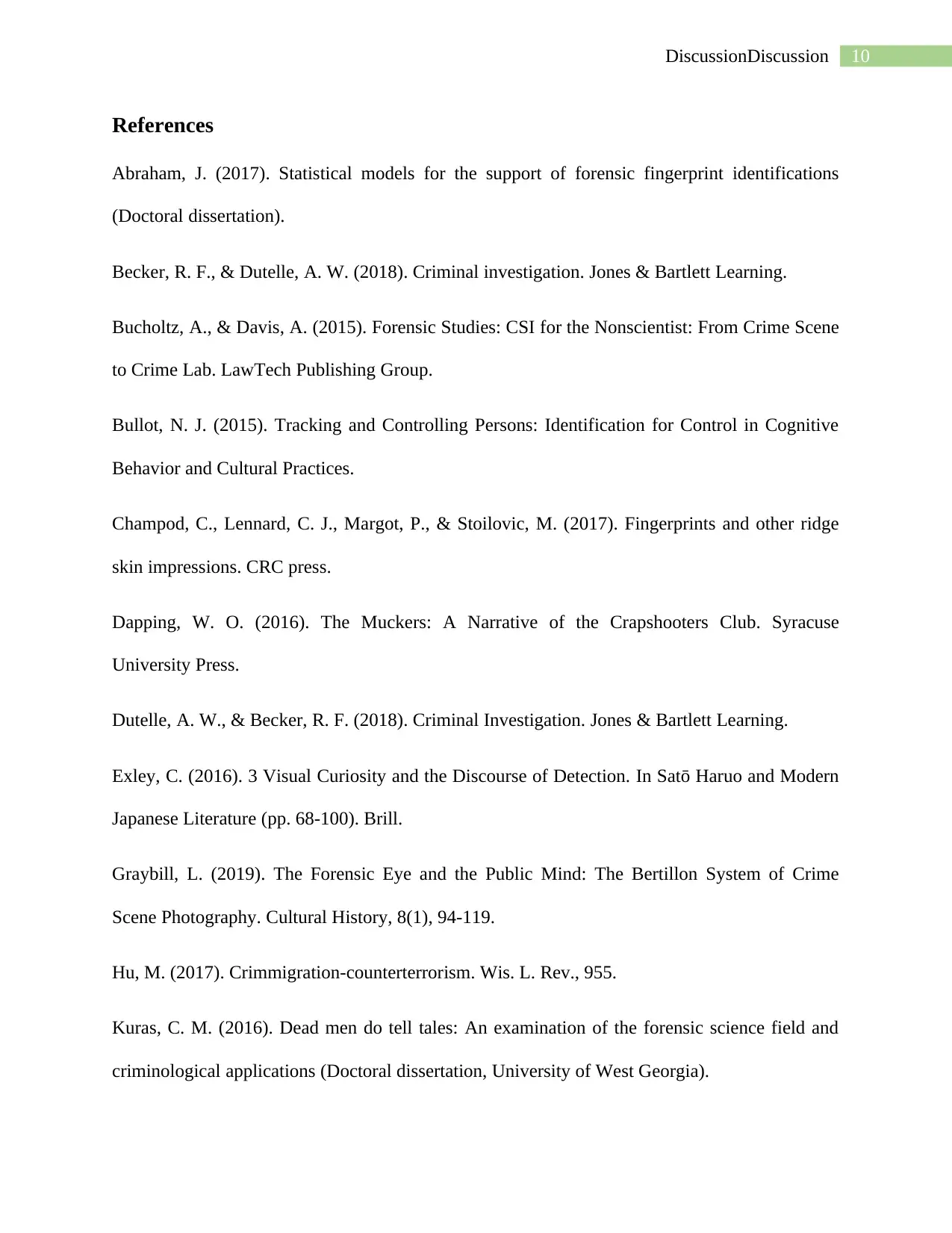
10DiscussionDiscussion
References
Abraham, J. (2017). Statistical models for the support of forensic fingerprint identifications
(Doctoral dissertation).
Becker, R. F., & Dutelle, A. W. (2018). Criminal investigation. Jones & Bartlett Learning.
Bucholtz, A., & Davis, A. (2015). Forensic Studies: CSI for the Nonscientist: From Crime Scene
to Crime Lab. LawTech Publishing Group.
Bullot, N. J. (2015). Tracking and Controlling Persons: Identification for Control in Cognitive
Behavior and Cultural Practices.
Champod, C., Lennard, C. J., Margot, P., & Stoilovic, M. (2017). Fingerprints and other ridge
skin impressions. CRC press.
Dapping, W. O. (2016). The Muckers: A Narrative of the Crapshooters Club. Syracuse
University Press.
Dutelle, A. W., & Becker, R. F. (2018). Criminal Investigation. Jones & Bartlett Learning.
Exley, C. (2016). 3 Visual Curiosity and the Discourse of Detection. In Satō Haruo and Modern
Japanese Literature (pp. 68-100). Brill.
Graybill, L. (2019). The Forensic Eye and the Public Mind: The Bertillon System of Crime
Scene Photography. Cultural History, 8(1), 94-119.
Hu, M. (2017). Crimmigration-counterterrorism. Wis. L. Rev., 955.
Kuras, C. M. (2016). Dead men do tell tales: An examination of the forensic science field and
criminological applications (Doctoral dissertation, University of West Georgia).
References
Abraham, J. (2017). Statistical models for the support of forensic fingerprint identifications
(Doctoral dissertation).
Becker, R. F., & Dutelle, A. W. (2018). Criminal investigation. Jones & Bartlett Learning.
Bucholtz, A., & Davis, A. (2015). Forensic Studies: CSI for the Nonscientist: From Crime Scene
to Crime Lab. LawTech Publishing Group.
Bullot, N. J. (2015). Tracking and Controlling Persons: Identification for Control in Cognitive
Behavior and Cultural Practices.
Champod, C., Lennard, C. J., Margot, P., & Stoilovic, M. (2017). Fingerprints and other ridge
skin impressions. CRC press.
Dapping, W. O. (2016). The Muckers: A Narrative of the Crapshooters Club. Syracuse
University Press.
Dutelle, A. W., & Becker, R. F. (2018). Criminal Investigation. Jones & Bartlett Learning.
Exley, C. (2016). 3 Visual Curiosity and the Discourse of Detection. In Satō Haruo and Modern
Japanese Literature (pp. 68-100). Brill.
Graybill, L. (2019). The Forensic Eye and the Public Mind: The Bertillon System of Crime
Scene Photography. Cultural History, 8(1), 94-119.
Hu, M. (2017). Crimmigration-counterterrorism. Wis. L. Rev., 955.
Kuras, C. M. (2016). Dead men do tell tales: An examination of the forensic science field and
criminological applications (Doctoral dissertation, University of West Georgia).
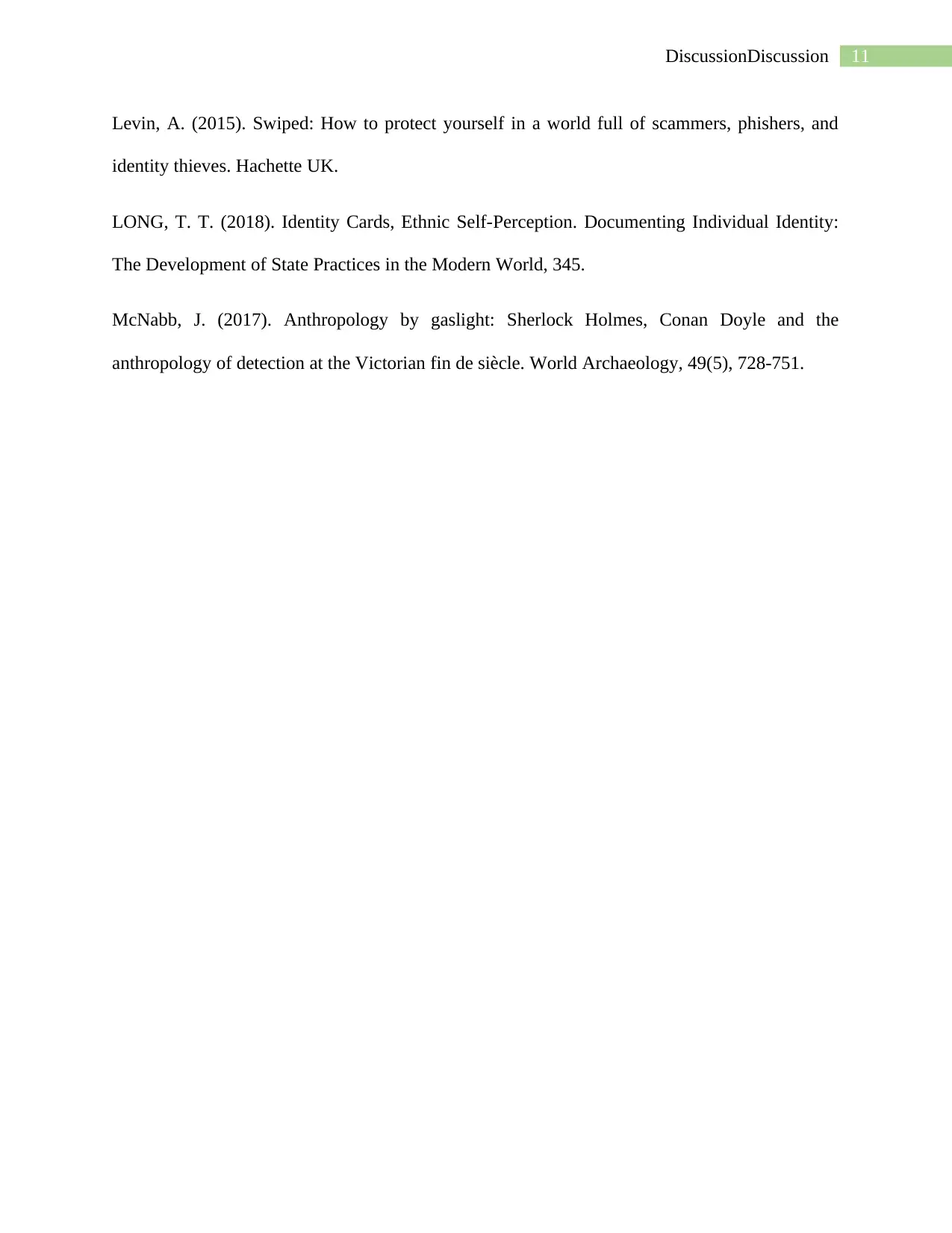
11DiscussionDiscussion
Levin, A. (2015). Swiped: How to protect yourself in a world full of scammers, phishers, and
identity thieves. Hachette UK.
LONG, T. T. (2018). Identity Cards, Ethnic Self-Perception. Documenting Individual Identity:
The Development of State Practices in the Modern World, 345.
McNabb, J. (2017). Anthropology by gaslight: Sherlock Holmes, Conan Doyle and the
anthropology of detection at the Victorian fin de siècle. World Archaeology, 49(5), 728-751.
Levin, A. (2015). Swiped: How to protect yourself in a world full of scammers, phishers, and
identity thieves. Hachette UK.
LONG, T. T. (2018). Identity Cards, Ethnic Self-Perception. Documenting Individual Identity:
The Development of State Practices in the Modern World, 345.
McNabb, J. (2017). Anthropology by gaslight: Sherlock Holmes, Conan Doyle and the
anthropology of detection at the Victorian fin de siècle. World Archaeology, 49(5), 728-751.
⊘ This is a preview!⊘
Do you want full access?
Subscribe today to unlock all pages.

Trusted by 1+ million students worldwide
1 out of 13
Your All-in-One AI-Powered Toolkit for Academic Success.
+13062052269
info@desklib.com
Available 24*7 on WhatsApp / Email
![[object Object]](/_next/static/media/star-bottom.7253800d.svg)
Unlock your academic potential
Copyright © 2020–2025 A2Z Services. All Rights Reserved. Developed and managed by ZUCOL.